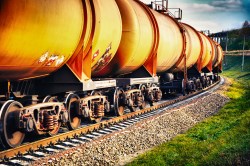It looks like Keystone pipeline protesters are having an unintended impact. Thanks in part to anti-pipeline activism, oil in North America is increasingly being shipped by train. So far this trend has been little noticed by the environmental community, but it’s big news in the rail world. From Railway Age:
“Railroads are booming, and [the reason] is oil,” reports the well-known and highly respected stock market news and financial analysis website Seeking Alpha. “Railroad stocks are ready to leap on booming oil transportation.”
The boom started in January, when President Obama denied approval for pipeline operator TransCanada’s proposed $7 billion Keystone XL pipeline, which would carry oil from Canada’s oil sands to U.S. Gulf Coast refineries. …
The U.S. Energy Information Administration (EIA) says rail deliveries of oil and petroleum rose almost 40% in this year’s first half. BNSF, the biggest railway mover of crude in the U.S., posted an increase of 60% in carloads of crude oil and petroleum products during that period.
Bloomberg Businessweek reports on the trend as well:
Rail transport of crude in North America has jumped by about 360,000 barrels a day in the past year — the equivalent of adding a “major” pipeline, according to Steven Paget, an analyst at FirstEnergy Capital Corp. in Calgary. Those shipments have soared as community protests slow new pipelines and oil finds occur outside the current pipe network.
As the Edmonton Journal explains, “Railways have been carrying oil for a century and were the only way to move crude before major pipelines were developed beginning in the 1940s,” but after pipeline networks were developed, the rail option became too expensive and fell out of favor until just recently.
Pipelines still carry the vast majority of oil in North America, but the rail percentage is rising fast. Railroad companies are making sizeable investments to build and upgrade infrastructure in anticipation of a boom in oil transport. One company is proposing a new rail line to pipe tar-sands crude from Alberta, Canada, to a supertanker port in Valdez, Alaska, potentially competing with the controversial Northern Gateway pipeline that Canadian pipeline giant Enbridge wants to build from Alberta to the coast of British Columbia. Even Enbridge is getting in on the oil-by-rail action via its U.S. subsidiary Enbridge Rail.
“Environmental and first nations opposition have created numerous hurdles for the pipeline industry, whose leaders are re-thinking how they can convince a skeptical public to accept their projects,” reports the Toronto Globe and Mail. In the meantime, “companies scramble to find new ways to market, largely by loading oil onto rail cars that are now carrying hundreds of thousands of barrels a day across the continent.”
Rail lines already crisscross North America and rail companies are already permitted to carry oil. “Unlike pipelines, that means no public hearings and no environmental protests,” reports the Edmonton Journal.
This shift back to trains isn’t being driven only by protests against pipelines — lots of powerful factors are at play. U.S. oil production is on the upswing thanks to fracking, and Canadian oil production is too thanks to both fracking and tar-sands mining. That means there’s increased competition for pipeline capacity — where it exists. “All of the crude oil export pipelines [from Canada to the U.S.] are pretty much full, running at maximum capacity,” Enbridge VP Vern Yu said last week.
And lots of the fracked oil is coming from areas that aren’t currently served by pipelines and might not have big enough reserves to make pipeline construction worthwhile.
We noted earlier this month that tar-sands oil has started being shipped by rail out of Alberta down toward Mississippi. Last week, the first big rail shipment of oil from North Dakota arrived in Tacoma, Wash., on a 103-car train, as the Tacoma News Tribune reports:
That Burlington Northern Santa Fe Railway train was the first of what will ultimately become weekly trains bringing oil to Tacoma from the new oil fields opened up by hydraulic fracturing technology in the country’s northern Great Plains. …
Because of the sudden rise in production in the Bakken and Three Forks shale formations in the Dakotas and Montana — production has more than quadrupled in five years — the usual means of transporting oil, pipelines, have not kept up to the demand.
Railroads are filling the gap in crude oil transport capacity, creating long trains typically numbering over 100 cars to carry that crude oil to refineries. Train transport is more expensive than pipeline movements …, but it takes only months to get the crude oil trains rolling versus years to build new pipelines.
Some industry watchers say the price difference is diminishing: “The cost of rail versus pipe isn’t hugely significant these days, especially now with the increased regulations and delays on pipelining,” Crescent Point Energy Corp. CEO Scott Saxberg told the Globe and Mail. “We see it being in the $2 a barrel range.”
Plus rail can be easier and quicker: “One of the advantages with rail is that it can go anywhere,” David Tyerman, an analyst with Canaccord Genuity Inc. in Toronto, told Businessweek. “Speed to market is also an advantage for rail, so there would probably be a market even if there was more pipeline capacity.”
Oil and rail companies are particularly interested in getting crude to coastal ports and overseas markets. Some firms “have begun examining exports to Europe through Atlantic Canada ports accessible by rail,” reports the Globe and Mail. The proposed rail line from Alberta to Alaska, mentioned above, is aimed at getting oil to Asia. And two companies want to export oil from a proposed rail-to-ship facility in Aberdeen, Wash., to Asian markets.
Environmental and community activists, in addition to fighting the Keystone and Gateway pipelines, have recently ramped up efforts to stop the export of coal from coastal terminals. Now they may need to broaden their focus to include oil-by-train schemes and rail-to-ship terminals. A couple of groups in the Aberdeen area already have.
“We didn’t like the coal trains at [a proposed] one a day. Are we going to like the oil trains better at two a day? I don’t think so,” Arnie Martin of the Grays Harbor Audubon Society told the Aberdeen Daily World.
But green groups are going to have to get moving if they want to slow this juggernaut. The North American oil industry is booming, and oil companies will do anything it takes to get that crude to market.
Read also: How the oil boom in Montana has turned railroads into a pipeline




